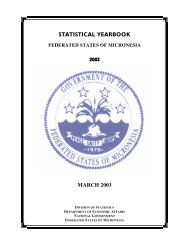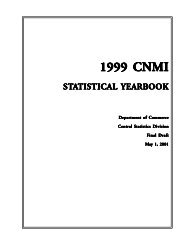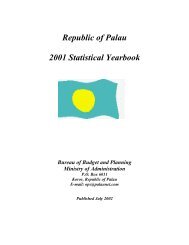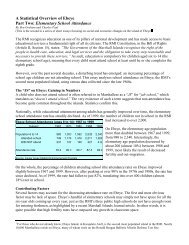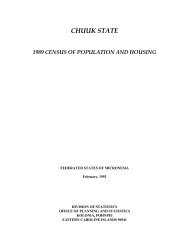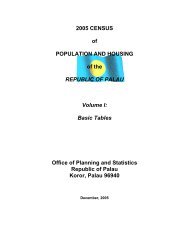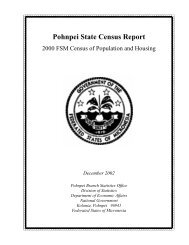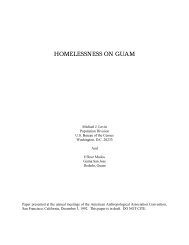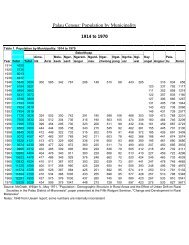Chapter 9. Economic Activity2000 FSM <strong>Census</strong> of <strong>Chuuk</strong> <strong>State</strong>The current work force included both formal workers and agricultural and fishing workers, and all persons at a paidjob. Current workers were only those persons who responded about their jobs in the week before the census.Persons sick or temporarily absent from a job were not included in the current work force.Limitations and comparability. The above definitions follow the recommendations of the Conference of LaborStatisticians and the global and regional recommendations of the United Nations International Labor Organization(ILO). The definitions differ from the U.S. Bureau of <strong>Census</strong> labor force definitions in two ways. First, the U.S.definition of labor force does not include subsistence, while the ILO definition does; the second difference is that theage limit in the U.S. is usually for persons aged 16 and over, while ILO uses aged 15 and over. The two methodsresult in different labor force participation rates and unemployment rates. Although the ILO method is presented inthis chapter, a table based on the U.S. definitions is presented in the basic tables section of this report (Table B15).The question for classifying persons in subsistence agriculture and fishing activities into the ‘subsistence’ and‘market-oriented’ subgroups differed slightly between 1994 and 2000. The 1994 <strong>Census</strong> classified personsaccording to the primary purpose (pure subsistence or market oriented) of the main type of subsistence activity(fishing, gardening, etc.), allowing for only the main activity to be captured. In 2000, the question allowed formultiple answers, but did not distinguish between main and secondary activities and classified persons who ‘soldany’ as market orientated. Thus, a subsistence worker mainly engaged in gardening for home consumption whosometimes fished to sell would be classified as pure-subsistence worker according to 1994 definitions. In 2000,he/she would be classified as a market-oriented worker.Analysis of Economic Activity DataLabor Force ParticipationTable 9.1 reports the total population of working age in <strong>Chuuk</strong> <strong>State</strong> for 1994 and 2000. For census year 2000, theworking age population was 31,586, of whom 18,192 persons, or 58 percent, were in the labor force and 13,395, or42 percent, were not in the labor force. This proportion of not in the labor force was the highest among the FSMstates in 1994. Of 8,922 in the employed labor force, three-fifths were engaged in a job or business outside of theagricultural sector. The remaining two-fifths of the employed labor force were engaged in farming and fishing, thegreat majority of whom (88 percent) were involved in 'subsistence' activities only, not selling or intending to sell anyof their produce. This result illustrates the importance of the subsistence sector in <strong>Chuuk</strong> <strong>State</strong> and the need toinclude such workers in the definition of the labor force to fully reflect their contribution to the domestic productionof the state. On the other hand, 'market-oriented' farmers and fishermen constituted about 12 out of every 100persons aged 15 and over of the agricultural and fishing sector.By 2000, the total population of working age in <strong>Chuuk</strong> <strong>State</strong> was 31,587, of whom 18,192, or 58 percent, were in thelabor force and 13,395, or 42 percent, were not in the labor force. Of the 31,587 potential working-age persons,almost 20 percent (6,213 persons) were unemployed or were looking and available for work and about 38 percent(11,979 persons) were employed in the formal, agriculture and fishing sectors.A comparison of work status by region shows significant variations among regions. In 1994, Northern Namoneas,Mortlocks and Oksoritod had the largest proportions of the working age population in the labor force while Faichukand Southern Namoneas had the smallest portion. Northern Namoneas had a larger proportion of employed persons informal work while the Mortlocks and the Oksoritod had a larger proportion of subsistence in agriculture/fishing. In2000, Southern Namoneas, Faichuk and Mortlocks had the largest proportions of the working age population in thelabor force. Interestingly, Northern Namoneas and Oksoritod had the smaller proportion of employed persons in thelabor force whereas four earlier in 1994, they were the highest.In 1994, nearly 62 percent of the total working age population in <strong>Chuuk</strong> was not in the labor force. In other words,more than three-fifth of the working age population in <strong>Chuuk</strong> did not have a job and was not looking for work. Theproportions were higher in the Lagoon Area than in the Outer Islands. Six years later in 2000 the total percentage ofworking age population not in the labor force a week before the census declined to about 42 percent. This suggested animprovement due to a decrease in the proportion of people not in the labor force.76 <strong>Chuuk</strong> Branch Statistics Office, Division of Statistics, FSM Department of Economic Affairs
2000 FSM <strong>Census</strong> of <strong>Chuuk</strong> <strong>State</strong>Chapter 9. Economic ActivityUnemployment rates, labor force participation rates and subsistence are compared among the regions later in thischapter.Table 9.1: Distribution of Working-Age Population for Aged 15 Years and Over by Region, <strong>Chuuk</strong> <strong>State</strong>: 1994 and 20001994 2000Labor Force Status Total N. Namon. S. Namon. Faichuk Mortlocks Oksoritod Total N. Namon. S. Namon. Faichuk Mortlocks OksoritodPersons 15+ years 29,068 9,904 6,326 6,470 3,593 2,775 31,587 9,276 6,771 7,730 4,170 3,640In labor force 11,140 4,031 2,165 2,034 1,574 1,336 18,192 5,016 4,182 4,725 2,540 1,729Employed 8,922 3,483 1,684 1,291 1,325 1,139 11,979 3,145 3,215 2,846 1,693 1,080Formal work 5,373 3,067 860 613 576 257 4,546 2,204 739 607 681 315Agriculture/Fishing 3,549 416 824 678 749 882 7,433 941 2,476 2,239 1,012 765Subsistence 3,119 297 707 540 737 838 5,134 654 1,465 1,452 938 625Market Oriented 430 119 117 138 12 44 2,299 287 1,011 787 74 140Unemployed 2,218 548 481 743 249 197 6,213 1,871 967 1,879 847 649Not in labor force 17,928 5,873 4,161 4,436 2,019 1,439 13,395 4,260 2,589 3,005 1,630 1,911Could have taken job 3,335 545 851 1,184 231 524 795 244 180 219 118 34Not available for work 14,593 5,328 3,310 3,252 1,788 915 12,600 4,016 2,409 2,786 1,512 1,877Percent 100.0 100.0 100.0 100.0 100.0 100.0 100.0 100.0 100.0 100.0 100.0 100.0In labor force 38.3 40.7 34.2 31.4 43.8 48.1 57.6 54.1 61.8 61.1 60.9 47.5Employed 30.7 35.2 26.6 20.0 36.9 41.0 37.9 33.9 47.5 36.8 40.6 29.7Formal work 18.5 31.0 13.6 9.5 16.0 9.3 14.4 23.8 10.9 7.9 16.3 8.7Agriculture/Fishing 12.2 4.2 13.0 10.5 20.8 31.8 23.5 10.1 36.6 29.0 24.3 21.0Subsistence 10.7 3.0 11.2 8.3 20.5 30.2 16.3 7.1 21.6 18.8 22.5 17.2Market Oriented 1.5 1.2 1.8 2.1 0.3 1.6 7.3 3.1 14.9 10.2 1.8 3.8Unemployed 7.6 5.5 7.6 11.5 6.9 7.1 19.7 20.2 14.3 24.3 20.3 17.8Not in labor force 61.7 59.3 65.8 68.6 56.2 51.9 42.4 45.9 38.2 38.9 39.1 52.5Could have taken job 11.5 5.5 13.5 18.3 6.4 18.9 2.5 2.6 2.7 2.8 2.8 0.9Not available for work 50.2 53.8 52.3 50.3 49.8 33.0 39.9 43.3 35.6 36.0 36.3 51.6Source: 1994 FSM <strong>Census</strong>, Table P26; 2000 FSM <strong>Census</strong>, Table P2-14.Table 9.2 illustrates the distribution of working age population by gender in the labor force. In 1994, although almosthalf (49.5 percent) of the working-age population were females, they accounted for only about a third (32.2 percent) ofthe labor force and slightly over a quarter (26.4 percent) in the employed population but more than half (55.4 percent)in the unemployed population. The preceding information showed how underrepresented the female working-agepopulation was in the <strong>State</strong> of <strong>Chuuk</strong> during the 1994 <strong>Census</strong>. By the year 2000, the female representation in the workforce had substantially improved, showing a participation rate of about 41.9 percent or two-fifths in the labor force,39.1 percent in the employed population, and slightly less than half (47.4 percent) in the unemployed population. Thissuggested that representation of female to male in the work force is gradually becoming more equal. The proportion offemales ‘not in the labor force’ is still higher than the proportion of males.Table 9.2: Distribution of Working Age Population for Aged 15 Years and Over by Sex, <strong>Chuuk</strong> <strong>State</strong>: 1994 and 20001994 2000Number Percent Proportion Number Percent ProportionLabor force Total Males Females Males Females females Total Males Females Males Females femalesTotal 29,068 14,687 14,381 14,687 14,381 49.5 31,587 15,782 15,805 15,782 15,805 50.0… … … 100.0 100.0 … … … … 100.0 100.0 …Labor force 11,140 7,557 3,583 51.5 24.9 32.2 18,192 10,568 7,624 67.0 48.2 41.9Employed 8,922 6,568 2,354 44.7 16.4 26.4 11,979 7,300 4,679 46.3 29.6 39.1Formal work 5,373 3,828 1,545 26.1 10.7 28.8 4,546 3,261 1,285 20.7 8.1 28.3Agriculture/fishing 3,549 2,740 809 18.7 5.6 22.8 7,433 4,039 3,394 25.6 21.5 45.7Subsistence 3,119 2,375 744 16.2 5.2 23.9 5,134 2,710 2,424 17.2 15.3 47.2Market oriented 430 365 65 2.5 0.5 15.1 2,299 1,329 970 8.4 6.1 42.2Unemployed 2,218 989 1,229 6.7 8.5 55.4 6,213 3,268 2,945 20.7 18.6 47.4Not in labor force 17,928 7,130 10,798 48.5 75.1 60.2 13,395 5,214 8,181 33.0 51.8 61.1Could have taken a job 3,335 1,156 2,179 7.9 15.2 65.3 795 317 478 2.0 3.0 60.1Not available for work 14,593 5,974 8,619 40.7 59.9 59.1 12,600 4,897 7,703 31.0 48.7 61.1Source: 1994 FSM <strong>Census</strong>, Table P26; 2000 FSM <strong>Census</strong>, Table P2-14.Table 9.3 portrays the distribution of the labor force by sex across the regions in 1994 and 2000. In 1994 the Lagoonregion made up over 73 percent of <strong>Chuuk</strong> <strong>State</strong>'s total labor force, and the Outer Islands made up 26 percent. In 2000,the Lagoon region increased to about 78 percent of <strong>Chuuk</strong> <strong>State</strong>’s total labor force, while the Outer Islands decreased toless than a quarter (22 percent). In 1994, 68 percent of the total labor forces were males and 32 percent were femaleswhile in 2000, 58 percent of the labor force were males and 42 percent were females. This showed a decreasingproportion of males and an increasing proportion of females in the labor force between 1994 and 2000. Interestingly,women's largest and smallest contributions to <strong>Chuuk</strong>’s labor force occurred in the Outer Islands particularly, in theOksoritod area. In 1994 women’s largest contribution to state labor force was in Pattiw (43 percent), and in 2000, wasin Namonuito (48 percent). Women's smallest contribution for both censuses occurred in Halls, at 26 and 40 percent of<strong>Chuuk</strong> Branch Statistics Office, Division of Statistics, FSM Department of Economic Affairs 77
- Page 5:
iii
- Page 12 and 13:
Preface2000 FSM Census of Chuukx
- Page 14 and 15:
Table of contents2000 FSM Census of
- Page 16 and 17:
LIST OF TEXT TABLESTABLEPageChapter
- Page 18 and 19:
List of Text Table2000 FSM Census o
- Page 20 and 21:
LIST OF FIGURESFIGUREPageFigure 1.1
- Page 22 and 23:
List of Basic-Tables2000 FSM Census
- Page 24 and 25:
MAP OF FSMxxiiChuuk Branch Statisti
- Page 27 and 28:
2000 FSM Census of Chuuk StateExecu
- Page 29 and 30:
CHAPTER 1INTRODUCTIONThe creation o
- Page 31 and 32:
2000 FSM Census of Chuuk StateChapt
- Page 33 and 34:
2000 FSM Census of Chuuk StateChapt
- Page 35 and 36:
2000 FSM Census of Chuuk StateChapt
- Page 37 and 38:
2000 FSM Census of Chuuk StateChapt
- Page 39 and 40:
2000 FSM Census of Chuuk StateChapt
- Page 41 and 42:
2000 FSM Census of Chuuk StateChapt
- Page 43 and 44:
2000 FSM Census of Chuuk State Chap
- Page 45:
2000 FSM Census of Chuuk StateChapt
- Page 48 and 49:
Chapter 2. Age and Sex Structure200
- Page 50 and 51:
Chapter 2. Age and Sex Structure200
- Page 52 and 53:
Chapter 2. Age and Sex Structure200
- Page 55 and 56: CHAPTER 3HOUSEHOLDS, FAMILIES, AND
- Page 57 and 58: 2000 FSM Census of Chuuk StateChapt
- Page 59 and 60: 2000 FSM Census of Chuuk StateChapt
- Page 61: 2000 FSM Census of Chuuk StateChapt
- Page 64 and 65: Chapter 4. Fertility2000 FSM Census
- Page 66 and 67: Chapter 4. Fertility2000 FSM Census
- Page 68 and 69: Chapter 4. Fertility2000 FSM Census
- Page 71 and 72: CHAPTER 5MORTALITYIntroductionAs re
- Page 73 and 74: 2000 FSM Census of Chuuk StateChapt
- Page 75: 2000 FSM Census of Chuuk StateChapt
- Page 78 and 79: Chapter 6. Migration2000 FSM Census
- Page 80 and 81: Chapter 6. Migration2000 FSM Census
- Page 82 and 83: Chapter 6. Migration2000 FSM Census
- Page 84 and 85: Chapter 6. Migration2000 FSM Census
- Page 86 and 87: Chapter 7. Religion, Ethnicity, and
- Page 88 and 89: Chapter 7. Religion, Ethnicity, and
- Page 90 and 91: Chapter 7. Religion, Ethnicity, and
- Page 92 and 93: Chapter 8. Education2000 FSM Census
- Page 94 and 95: Chapter 8. Education2000 FSM Census
- Page 96 and 97: Chapter 8. Education2000 FSM Census
- Page 98 and 99: Chapter 8. Education2000 FSM Census
- Page 100 and 101: Chapter 8. Education2000 FSM Census
- Page 103: CHAPTER 9ECONOMIC ACTIVITYIntroduct
- Page 107 and 108: 2000 FSM Census of Chuuk StateChapt
- Page 109 and 110: 2000 FSM Census of Chuuk StateChapt
- Page 111 and 112: 2000 FSM Census of Chuuk StateChapt
- Page 113 and 114: 2000 FSM Census of Chuuk StateChapt
- Page 115 and 116: 2000 FSM Census of Chuuk StateChapt
- Page 117 and 118: CHAPTER 10INDUSTRY AND OCCUPATIONIn
- Page 119 and 120: 2000 FSM Census of Chuuk StateChapt
- Page 121 and 122: 2000 FSM Census of Chuuk StateChapt
- Page 123 and 124: 2000 FSM Census of Chuuk StateChapt
- Page 125 and 126: 2000 FSM Census of Chuuk StateChapt
- Page 127 and 128: 2000 FSM Census of Chuuk StateChapt
- Page 129 and 130: CHAPTER 11INCOMEIntroductionThe 200
- Page 131 and 132: 2000 FSM Census of Chuuk StateChapt
- Page 133 and 134: 2000 FSM Census of Chuuk StateChapt
- Page 135 and 136: 2000 FSM Census of Chuuk StateChapt
- Page 137: 2000 FSM Census of Chuuk StateChapt
- Page 140 and 141: Chapter 12. Housing2000 FSM Census
- Page 142 and 143: Chapter 12. Housing2000 FSM Census
- Page 144 and 145: Chapter 12. Housing2000 FSM Census
- Page 146 and 147: Chapter 12. Housing2000 FSM Census
- Page 148 and 149: Chapter 12. Housing2000 FSM Census
- Page 150 and 151: Chapter 12. Housing2000 FSM Census
- Page 152 and 153: Chapter 12. Housing2000 FSM Census
- Page 154:
Chapter 12. Housing2000 FSM Census
- Page 157 and 158:
BIBLIOGRAPHYArriaga, E.E., (1983).
- Page 159:
2000 FSM Census of Chuuk StateBibli
- Page 162 and 163:
Basic Tables2000 FSM Census of Chuu
- Page 164 and 165:
Basic Tables2000 FSM Census of Chuu
- Page 166 and 167:
Basic Tables2000 FSM Census of Chuu
- Page 168 and 169:
Basic Tables2000 FSM Census of Chuu
- Page 170 and 171:
Basic Tables2000 FSM Census of Chuu
- Page 172 and 173:
Basic Tables2000 FSM Census of Chuu
- Page 174 and 175:
Basic Tables2000 FSM Census of Chuu
- Page 176 and 177:
Basic Tables2000 FSM Census of Chuu
- Page 178 and 179:
Basic Tables2000 FSM Census of Chuu
- Page 180 and 181:
Basic Tables2000 FSM Census of Chuu
- Page 182 and 183:
Basic Tables2000 FSM Census of Chuu
- Page 184 and 185:
Basic Tables2000 FSM Census of Chuu
- Page 186 and 187:
Basic Tables2000 FSM Census of Chuu
- Page 188 and 189:
Basic Tables2000 FSM Census of Chuu
- Page 190 and 191:
Basic Tables2000 FSM Census of Chuu
- Page 192 and 193:
Basic Tables2000 FSM Census of Chuu
- Page 194 and 195:
Basic Tables2000 FSM Census of Chuu
- Page 196 and 197:
Basic Tables2000 FSM Census of Chuu
- Page 198 and 199:
Basic Tables2000 FSM Census of Chuu
- Page 200 and 201:
Basic Tables2000 FSM Census of Chuu
- Page 202 and 203:
Basic Tables2000 FSM Census of Chuu
- Page 204 and 205:
Basic Tables2000 FSM Census of Chuu
- Page 206 and 207:
Basic Tables2000 FSM Census of Chuu
- Page 208 and 209:
Basic Tables2000 FSM Census of Chuu
- Page 210 and 211:
Basic Tables2000 FSM Census of Chuu
- Page 212 and 213:
Basic Tables2000 FSM Census of Chuu
- Page 214 and 215:
Basic Tables2000 FSM Census of Chuu
- Page 216 and 217:
Basic Tables2000 FSM Census of Chuu
- Page 218 and 219:
Basic Tables2000 FSM Census of Chuu
- Page 220 and 221:
Basic Tables2000 FSM Census of Chuu
- Page 222 and 223:
Basic Tables2000 FSM Census of Chuu
- Page 224 and 225:
Basic Tables2000 FSM Census of Chuu
- Page 226 and 227:
Basic Tables2000 FSM Census of Chuu
- Page 228 and 229:
Basic Tables2000 FSM Census of Chuu
- Page 230 and 231:
Basic Tables2000 FSM Census of Chuu
- Page 232 and 233:
Basic Tables2000 FSM Census of Chuu
- Page 234 and 235:
Basic Tables2000 FSM Census of Chuu
- Page 236 and 237:
Basic Tables2000 FSM Census of Chuu
- Page 238 and 239:
Basic Tables2000 FSM Census of Chuu
- Page 240 and 241:
Basic Tables2000 FSM Census of Chuu
- Page 242 and 243:
Basic Tables2000 FSM Census of Chuu
- Page 244 and 245:
Basic Tables2000 FSM Census of Chuu
- Page 246 and 247:
Basic Tables2000 FSM Census of Chuu
- Page 248 and 249:
Basic Tables2000 FSM Census of Chuu
- Page 250 and 251:
Basic Tables2000 FSM Census of Chuu
- Page 252 and 253:
Basic Tables2000 FSM Census of Chuu
- Page 254 and 255:
Basic Tables2000 FSM Census of Chuu
- Page 256 and 257:
Basic Tables2000 FSM Census of Chuu
- Page 258 and 259:
Basic Tables2000 FSM Census of Chuu
- Page 260 and 261:
Basic Tables2000 FSM Census of Chuu
- Page 262 and 263:
Basic Tables2000 FSM Census of Chuu
- Page 264 and 265:
Basic Tables2000 FSM Census of Chuu
- Page 266 and 267:
Basic Tables2000 FSM Census of Chuu
- Page 268 and 269:
Basic Tables2000 FSM Census of Chuu
- Page 270 and 271:
Basic Tables2000 FSM Census of Chuu
- Page 272 and 273:
Basic Tables2000 FSM Census of Chuu
- Page 274 and 275:
Basic Tables2000 FSM Census of Chuu
- Page 276 and 277:
Basic Tables2000 FSM Census of Chuu
- Page 278 and 279:
Basic Tables2000 FSM Census of Chuu
- Page 280 and 281:
Basic Tables2000 FSM Census of Chuu
- Page 282 and 283:
Basic Tables2000 FSM Census of Chuu
- Page 284 and 285:
Basic Tables2000 FSM Census of Chuu
- Page 286 and 287:
Basic Tables2000 FSM Census of Chuu
- Page 288 and 289:
Basic Tables2000 FSM Census of Chuu
- Page 290 and 291:
Basic Tables2000 FSM Census of Chuu
- Page 292 and 293:
Questionnaire2000 FSM Census of Chu
- Page 294 and 295:
Questionnaire2000 FSM Census of Chu
- Page 296 and 297:
Questionnaire2000 FSM Census of Chu



